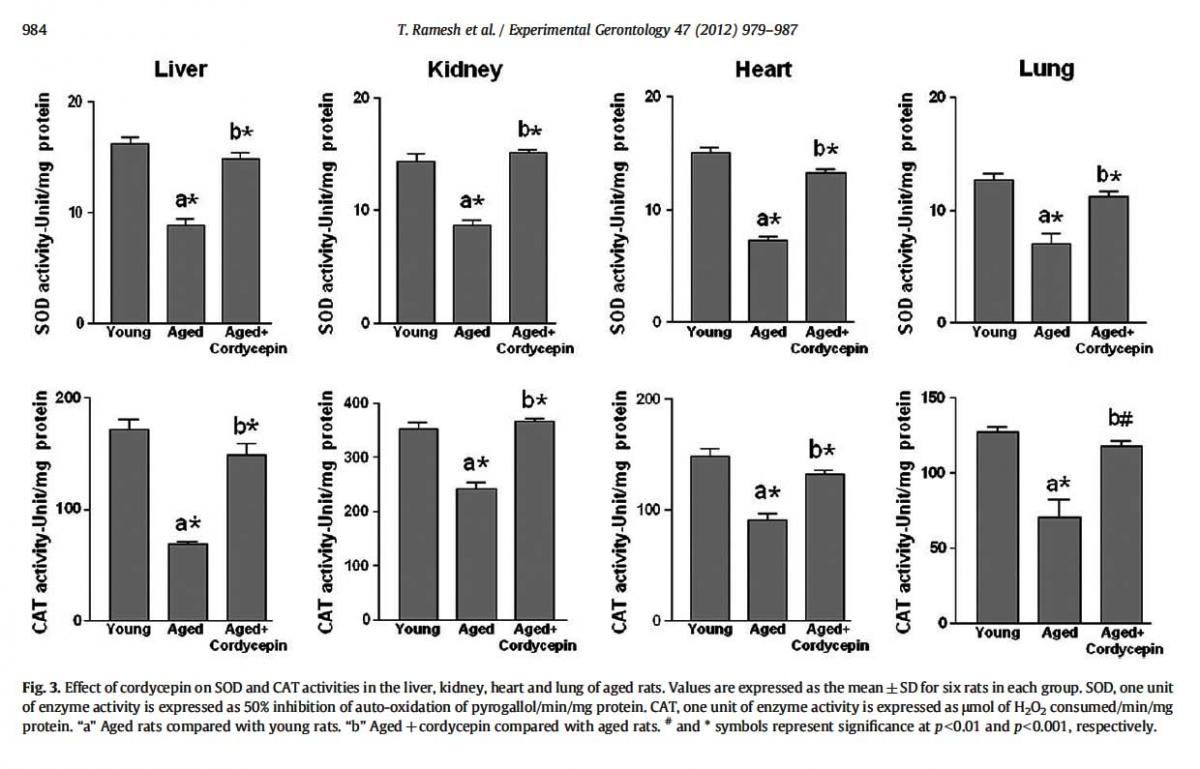Recently two interesting research papers on medical propensities of Cordycepin, the most well known of the active ingredients of wild Ophiocordyceps sinensis and also cultivated O.s as well as Cordyceps militaris, were published. The first study presents results of ongoing research at Nottingham University (UK) under the leadership of Dr. Cornelia De Moor. It is entitled: "Inhibition of polyadenylation reduces inflammatory gene induction" and published in RNA. The other paper published in Experimental Gerontology by a mostly Korean team is entitled: "Cordycepin (3′-deoxyadenosine) attenuates age-related oxidative stress and ameliorates antioxidant capacity in rats" and its summary - see below -closes with: "These results suggest that cordycepin is effective for restoring antioxidant status and decreasing lipid peroxidation in aged rats. Aging leads to the gradual loss of pro-oxidant/antioxidant balance and increase oxidative stress. Cordycepin treatment decrease oxidative stress and increase antioxidant status Cordycepin treatment can ameliorate antioxidants during aging and it might attenuate the age-associated disorders".
Now, I do not have the medical back ground to judge the content or the value of these research articles. However, the Nottingham study suggests that Cordycepin has anti-inflammatory capacity that is worth to be investigated further for potential drug development. The Korean study is packed with graphics that leave the impression that negative impact from aging on cellular level has been reduced substantially in rats that have been treated with Cordycepin.

Of course these studies do not address the medical value of natural Yartsa gunbu, the complex of the ghost moth larva taken over by caterpillar fungus - Ophiocordyceps sinensis. However, they clearly indicate that the attention that Yartsa gunbu as a medicinal fungus receives is not made out of thin air.
Kondrashov, A., Hedda A. Meijer, Adeline Barthet-Barateig, Hannah N. Parker, Asma Khurshid, Sarah Tessier, Marie Sicard, Alan J. Knox, Linhua Pang, and Cornelia H. De Moor 2012. Inhibition of polyadenylation reduces inflammatory gene induction. RNA 2012. 18: 2236-22502
ABSTRACT
Cordycepin (39 deoxyadenosine) has long been used in the study of in vitro assembled polyadenylation complexes, because it terminates the poly(A) tail and arrests the cleavage complex. It is derived from caterpillar fungi, which are highly prized in Chinese traditional medicine. Here we show that cordycepin specifically inhibits the induction of inflammatory mRNAs by cytokines in human airway smooth muscle cells without affecting the expression of control mRNAs. Cordycepin treatment results in shorter poly(A) tails, and a reduction in the efficiency of mRNA cleavage and transcription termination is observed, indicating that the effects of cordycepin on 39 processing in cells are similar to those described in in vitro reactions. For the CCL2 and CXCL1 mRNAs, the effects of cordycepin are post-transcriptional, with the mRNA disappearing during or immediately after nuclear export. In contrast, although the recruitment of RNA polymerase II to the IL8 promoter is also unaffected, the levels of nascent transcript are reduced, indicating a defect in transcription elongation. We show that a reporter construct with 39 sequences from a histone gene is unaffected by cordycepin, while CXCL1 sequences confer cordycepin sensitivity to the reporter, demonstrating that polyadenylation is indeed required for the effect of cordycepin on gene expression. In addition, treatment with another polyadenyation inhibitor and knockdown of poly(A) polymerase a also specifically reduced the induction of inflammatory mRNAs. These data demonstrate that there are differences in the 39 processing of inflammatory and housekeeping genes and identify polyadenylation as a novel target for anti-inflammatory drugs.
Thiyagarajan Ramesh, Sung-Kwang Yoo, Sung-Won Kim, Seock-Yeon Hwang, Sang-Hyun Sohn, Il-Woung Kim, Si-Kwan Kim 2012. Cordycepin (3′-deoxyadenosine) attenuates age-related oxidative stress and ameliorates antioxidant capacity in rats. Experimental Gerontology Volume 47, Issue 12, December 2012, p. 979–987
ABSTRACT:
Free radical-induced oxidative damage is considered to be the most important consequence of the aging process. The activities and capacities of antioxidant systems of cells decline with increased age, leading to the gradual loss of pro-oxidant/antioxidant balance and resulting in increased oxidative stress. Our investigation was focused on the effects of cordycepin (3'-deoxyadenosine) on lipid peroxidation and antioxidation in aged rats. Age-associated decline in the activities of superoxide dismutase (SOD), catalase (CAT), glutathione peroxidase (GPx), glutathione reductase (GR), glutathione-S-transferase (GST), reduced glutathione (GSH), vitamin C and vitamin E, and elevated levels of malondialdehyde (MDA) were observed in the liver, kidneys, heart and lungs of aged rats, when compared to young rats. Furthermore, serum aspartate aminotransferase (AST), alanine aminotransferase (ALT), urea, and creatinine were found to be significantly elevated in aged rats compared to young rats. Aged rats receiving cordycepin treatment shows increased activity of SOD, CAT, GPx, GR and GST, and elevated levels of GSH, and vitamins C and E such that the values of most of these parameters did not differ significantly from those found in young rats. In addition, the levels of MDA, AST, ALT, urea and creatinine became reduced upon administration of cordycepin to aged rats. These results suggest that cordycepin is effective for restoring antioxidant status and decreasing lipid peroxidation in aged rats. Aging leads to the gradual loss of pro-oxidant/antioxidant balance and increase oxidative stress. Cordycepin treatment decrease oxidative stress and increase antioxidant status Cordycepin treatment can ameliorate antioxidants during aging and it might attenuate the age-associated disorders.